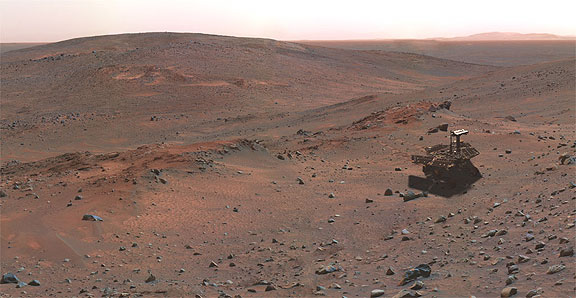
Spirit, the untiring robotic "wonder child" sent by NASA to explore the eerily earthlike fourth planet from the sun, has completed one martian year--that's almost two Earth years--on Mars. Designed to last only 90 martian days (sols), the six-wheeled marvel the size of a golf cart has pursued a steady course of solar-driven geologic fieldwork, bringing back some 70,000 images and a new understanding of Mars as a potential habitat.
While keeping warm in the winter, Spirit's uphill battle also centered on what NASA sent both rovers to find: signs of past water on Mars. If water persisted for long periods of time in martian history, the red planet might have once had a life-supporting environment. At first, Spirit's studies showed plenty of volcanic rocks, but few signs of minerals formed by water.
"Only by climbing did Spirit find what we were seeking," said Ray Arvidson, deputy principal investigator from Washington University in St. Louis. "With Spirit's engineering stamina, we finally found rocks in the 'Columbia Hills' that either formed in, or were altered by, water. Perhaps best of all, the hills hold the highest sulfur content ever found on Mars: sulfate salts, deposited by water."
Besides finding these prized signs of past water on Mars, Spirit has discovered at least five distinct classes of rocks. Among these are molten rocks blasted upward and outward during meteorite impacts, materials formed during violent volcanic explosions, and lava flows. Beyond these large features, Spirit has taken a close look at grain-sized rock particles as well. "At a small scale, the geology of 'Husband Hill' looks like it's been put in a blender," said Squyres.
Seeing this rich geologic record on the north side of the Columbia Hills, Arvidson says, heightens the science team's anticipation of what more they will learn about the history of the hills during Spirit's trek down the other side.
For Spirit's continued journey, engineers are delighted with the unlikely role the martian wind has played in increasing the rover's staying power. A peak threat of wind is the planet-encircling dust storms that can arise in martian spring through early summer, blocking out sunlight needed for power. "Luckily," said project scientist Joy Crisp, "we haven't yet seen a global dust storm since the rovers landed on Mars, but we have seen a lot of dust devils."
Dust devils occur when the wind whirls over the surface, stirring dust up like a miniature tornado and traveling up to 13 feet per second (4 meters per second). It turns out the dust devils are primarily a lunchtime affair, mostly occurring between 11 a.m. and 3 p.m. at each rover site. For both rovers, these noontime winds have been very favorable.
While dozens of dust devils have passed before Spirit's cameras, some have made contact, sweeping dust from the rover's solar panels. The solar panels are then able to take in more sunlight and convert it into electricity, keeping Spirit "alive" for even longer.
While no one can predict how long Spirit will last, the rover's stamina throughout the long martian year encourages hope. The science team is busy even now plotting new destinations to strive toward. If the "Columbia Hills" were once a distant dream, new far-off horizons beckon just as much. Getting there will stretch the rover's capabilities as much as the imagination. Team member Jim Rice calls one such distant target, a rough and rugged terrain to the south, "the Promised Land."





